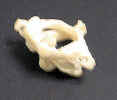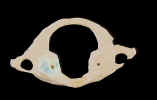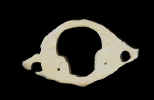

 Superior
view, atlas and axis
Superior
view, atlas and axis Superior
view, atlas and axis
Superior
view, atlas and axis Inferior view
Inferior view Superior view
Superior viewThe atlas is the name for the first cervical vertebra (C1). It is derived from a reference to the legendary person who held the world on his shoulders, much as the atlas holds the head (globe shaped) on its shoulders. The occipital condyles of the occipital bone articulate with the superior articular facets to form a tongue and groove joint that allows for flexion and extension of the skull. This is a specialized type of hinge joint. When one shakes their head "no" the occipital bone and atlas move as one piece. The atlantoaxial joint is a mortise and tenon joint which is a specialized type of pivot joint. It allows for rotation. The atlas is unusual in that it lacks a well developed spinous process. Another distinguishing feature is that there is no intervertebral disc between the atlas and the axis. There was a disc, but it becomes part of the dens and body of the axis when they fuse during fetal development or early childhood. The atlas has no body but does have an anterior arch and a posterior arch that connect the lateral masses. The lateral masses include the articular surfaces. The fact that it lacks a body led it to write the song "I ain't got no body!" for David Lee Roth.
COPYRIGHT
2007 by William C. Johnson II
ALL RIGHTS RESERVED!